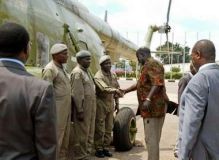GARANG CRASH – Russian manufacturer says not guilty
Oct 12, 2005 (MOSCOW) — Kazan Helicopters of Russia, the manufacturers of the Ugandan presidential helicopter that crashed on July 30, killing the former first vice president of Sudan Dr John Garang and 12 others, have released their own version of the mechanical condition of the chopper at the time of the crash.

|
|
First Vice-President John Garang shakes hands with crew members as he boards an Ugandan helicopter at Entebbe International Airport on his way to meet Uganda’s President Yoweri Museveni at his country home in Mbarara, western Uganda in July 29, 2005. (Reuters). |
One the main revelations is that the M1-172 helicopter no: 6270001 had only flown for only 20 hours after it had been overhauled and modernised in Russia between February and July this year.
One of the issues being investigated by a team of experts from the US, Sudan, Kenya and Uganda is whether or not the aircraft had flown enough hours after the overhaul and re-assembly to be ready to make the ill-fated flight to New Site in Southern Sudan.
At the time of the crash, the chopper had been in the country for barely week, having been received from the manufacturers on July 21.
Kazan’s position is contained in a letter to the charge de affairs of the Sudanese Embassy in Moscow, Fadlalla Elhadi Ebrahim, and signed by its marketing director, Valery A. Pashko.
The letter indicates that the Russians deny any culpability for the fatal accident, appearing to shift any blame for any mechanical problems which the chopper may have had on Ugandan engineers.
In the letter, the company argues that after overhauling the chopper, Ugandan authorities signed acceptance certificates without making any remarks, thus confirming that the chopper was in good mechanical condition.
Attached to the letter from the Russian company are two preliminary acceptance certificates signed by Ugandan officials.
The first, dated July 5, 2005, was signed on behalf of Uganda by a Colonel Turyagyenda. The second, a “certificate for receiving the aircraft after overhaul,” was signed by chief pilot Peter Nyakairi – who also perished in the crash – on behalf of the Comptroller of State House.
The signing followed ground and flight tests on July 5 and signified that the Ugandan authorities deemed the craft fit and proper.
Kazan also says that by the date of signing of the first certificate, the aircraft had done two hours and five minutes after the first overhaul. It was delivered to Uganda, reassembled and then subjected to final acceptance tests before it was released.
“All systems and equipment were tested both on the ground and in flight and no defects were found,” says the company in the letter.
The Russians maintain that long before the crash, the aircraft had become the responsibility of Ugandan technicians who were the ones to do all the pre-flight and after-flight maintenance checks and works.
With the theory of foul play having reportedly been discarded by the team investigating the fatal crash, indications are that the focus of the investigations is bound to shift to the mechanical condition and airworthiness of the chopper, especially the quality of the maintenance and overhaul that it underwent just before it crashed.
The investigations are likely to delve into the murky area of the chopper’s procurement in the first place, with investigators seeking details on the maintenance contracts for the chopper to determine whether what the Russians did was in line with contractual obligations.
– Several questions arise: Do Ugandan engineers vet the maintenance work done by the Russians for quality assurance and are the procedures for signing certificates effective?
– When the Ugandan State House officials were signing the acceptance certificates for the chopper, did they have the technical capacity to vet what the Russians had done?
What is clear, however, is that progress in this line of the investigation is not likely because the business of procuring helicopters and negotiating their maintenance contracts is regarded as a highly-sensitive political affair in Uganda.
Whether or not the investigating team will receive co-operation from Ugandan authorities as they pursue this line of investigations remains to be seen.
Depending on what emerges from the investigations about the condition of the chopper and the transparency of the maintenance contracts with the Russians, President Museveni may be forced to appoint another commission to have a fresh look into those maintenance contracts.
President Museveni expressed a great deal of confidence in the mechanical condition of the chopper. He stated that the chopper was a recently overhauled executive plane that had served the country well for the past eight years.
Museveni said that the helicopter had only recently been overhauled, with some of the instruments being upgraded.
He stated that the aircraft had the ability to show the pilot the altitude using both a radio altimeter that shows the distance from the ground as well as the barometer altimeter that shows how far the craft is above sea level.
(The EastAfrican/ST)
